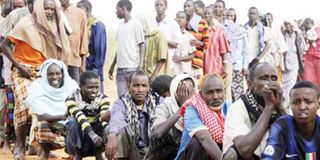UN global compact for migration must be made fit for purpose

What you need to know:
- It is still too early to prefigure the exact priorities and implementation modalities that will be in the final version of the GCM. However, reports emerging from theintergovernmental consultations suggest a dearth of novel and innovative leads that haven’t already been promoted or tested.
On December 3, 2017, President Donald Trump opted out of the UN Global Compact for Migration on the basis that US migration policy should be determined “by Americans and for Americans alone”. This came despite the fact that the compact only aims to establish a multilateral cooperation framework to facilitate safe, orderly, and regular migration internationally – not to set any binding rules that could potentially erode national sovereignty.
It is still too early to prefigure the exact priorities and implementation modalities that will be in the final version of the GCM. However, reports emerging from theintergovernmental consultations suggest a dearth of novel and innovative leads that haven’t already been promoted or tested.
First, while the ongoing consultations duly recognise the wide disparities in migration trends and policy approaches across the world, it’s still difficult to distinguish the group of countries or regions that will benefit most, and the ways in which its guiding principles, implementation procedures, and financing mechanisms will be modulated according to country- or region-specific needs and priorities.
Second, for a cooperation framework in such a policy-sensitive area as migration to prove effective and sustainable, it’s essential for its proposals to be seen as immediately relevant, practical, and actionable by all the participating states. A case in point is the GCM’s call for the development and sharing of appropriate migration data internationally. While this is of course a prerequisite to the formulation of any new policy device and revision, datasets alone cannot be seen as a panacea if they are not accompanied by appropriate contextual and guiding material.
In particular, a more policy-rich knowledge base that should be supported by the GCM should include an easily accessible inventory of good practices and “actionable options” for specific migration scenarios. Many challenges faced by states today, particularly at the local and micro levels, have been experienced and managed, successfully or otherwise, by other states at some point in the past. The lessons drawn from such experiences should be made easily accessible and organised by key problem area. This would allow for their possible replication in different national contexts and therefore prevent the repetition of unnecessary policy impasses.
Third, for the new compact to prove effective and potentially game-changing, it should be able to verify and demonstrate its policy relevance and applicability. This could be achieved by pilot testing the core policy mechanisms it advocates in a few voluntary states representing various regions, followed by appropriate evaluations of the most salient and policy-instructive outcomes.
For example, the GCM’s objective of creating new legal migration pathways is still insufficiently documented and tested. For many government officials, it is probably still a vague and potentially ambiguous concept.
While the European Commission has recently announced its intention to finance and coordinate pilot projects to promote selective legal economic migration from third countries to voluntary EU member states, particularly through the development of public-private partnerships, similar experiments should be trialled in other regions of the world – in conjunction with the ongoing discussions on global resettlement policy.
Fourth, multilateral cooperation in the field of migration also implies having easy access to suitable and clearly identifiable interlocutors in each participating state. Migration policy touches upon several issues that embrace a range of sectors and ministerial departments. For the GCM to be administered fluidly, each state should name an international migration ambassador to represent and share the range of concerns, policies, and decision-making prerogatives of their country with their counterparts in all the other participating states.
In the same vein, in order to establish an effective mechanism to monitor the implementation of the GCM in the coming years, there will be a need for an international task force consisting of national and local public authorities, independent migration experts, employers, business owners, investors, and civil society. While these are the actors who are currently participating in the GCM consultations, it would be essential that such a group be perpetuated after the GCM is finalised.
Among other things, this task force could be entrusted with the monitoring and evaluation at regular intervals of the relevance and impact, according to region, of the compact as it is agreed in mid-2018. As an independent expert and multi-stakeholder group, it could also gradually become a body that could be consulted informally by states and other entities to assess particular policies, at preparatory and mid-term stages, or even to investigate some of the possible negative outcomes of specific measures, particularly those relating to alleged fundamental rights violations.
The author is the managing director of Eurasylum and research fellow at the Institute of Labor Economics and the Global Labor Organization




